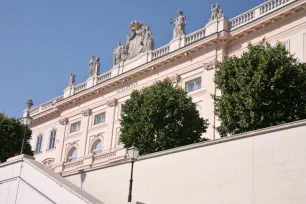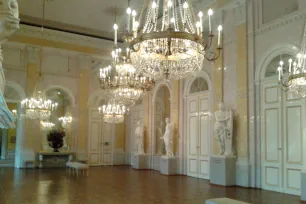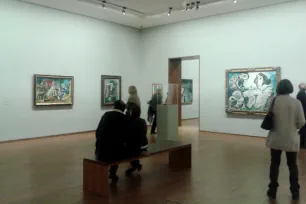The Albertina is a museum of graphic arts renowned for its vast collection of drawings and prints. Since 1805 the museum has been housed in the Albertina Palace, whose lavish state rooms are also open to visitors.
The name Albertina refers to Duke Albert of Saxe-Teschen, who founded the museum collection and resided in the palace from 1794 until his death in 1822.
The Albertina Palace
Early residents

The palace was built in 1744 on an elevated position atop the Augustinian bastion near the Hofburg and hugged the city walls. At the time it was named Tarouca Palace, after its first owner, Count Emanuel Silva-Tarouca. Duke Albert, who was the son-in-law of Empress Maria Theresa, moved into the building in 1794.
Albert ordered a complete remodeling of the palace, both inside and outside, in a neoclassical style. He also had the palace expanded and the architect, Louis Joseph Montoyer, even incorporated a section of the former Augustinian monastery into the building. When the remodeling was complete, the duke brought his already acclaimed collection of graphic art to the palace, and it has resided there ever since.
Post-war development
After the First World War, the Austrian government nationalized the building and its art collection. The Second World War had a much more disastrous effect on the Albertina Palace; the building was severely damaged and the State Rooms had been destroyed. The palace was rebuilt shortly after the war, but without the architectural details.
The palace today

Today the palace is back in full splendor, the result of a renovation that was carried out between 2000 and 2003. The entrance to the palace is on a raised terrace known as Albrechtsrampe, which can be reached by escalator or by ascending a majestic staircase. In the middle of the terrace, the equestrian statue of archduke Albrecht overlooks the area. The statue was created in 1899 by Kaspar Zumbusch to commemorate the archduke’s victory in the Battle of Custozza in 1866. The archduke lived in the Albertina Palace from 1847 to 1895.
The terrace is now partially covered with a huge cantilevered titanium slab. The conspicuous structure, designed by Hans Hollein, was installed in 2004. The terrace rests on a section of the old bastion, which is decorated with niches that hold large statues. At its southern tip is the Albrecht Fountain (1869), which shows a sculptural portrayal of the river god Danubius.
The State Rooms
As part of the renovation in the early 2000s, the so-called Prunkraume (state rooms) were also completely restored and are now open to the public. The rooms were decorated in a regal neoclassical style by Joseph Georg Kornhäusel.

The most impressive of these rooms is probably the Hall of the Muses, which is decorated with large chandeliers, statues, pilasters and stucco. Around it are the state apartments, decorated with silk linings and gilded ornaments. The furniture on display was tailor-made in the 1820s by the Viennese manufacturer Joseph Danhauser for Archduke Carl, who was the first to inflict defeat upon the French Emperor Napoleon.
The Albertina Museum
The collection of the museum was founded in 1768 by Albert of Saxe-Teschen, who during his lifetime had amassed an impressive 200,000 prints as well as some 14,000 drawings and watercolors, including works from famous artists such as Dürer and Michelangelo. Today the collection of the Albertina has expanded to about 50,000 drawings and 1,000,000 prints.
The Collections

The museum has three main collections encompassing architecture, photography and graphic art.
The architectural collection comprises some 50,000 plans and scale models. The photographic collection of the Albertina has tens of thousands of photographs, the oldest of which go back to the mid-nineteenth century.
By far the largest and most important collection is the graphic art collection. Due to the fragile nature of the works, only a small selection is displayed in rotating exhibits. The collection is arranged chronologically and spans a period from the Middle Ages to modern times. Especially renowned is the collection of Renaissance artwork, in particular the 120 works from the German painter Albrecht Dürer. His 1502 watercolor of a young hare is amongst the museum’s most prized assets. Other highlights include drawings by Pieter Bruegel the Elder and works by the Italian masters Raphael Santi and Michelangelo Buonarroti. The Baroque collection contains some magnificent sketches by Peter Paul Rubens and Rembrandt van Rijn.

Modern artists are also well represented. Pre-war highlights include impressionist works from French artists such as Édouard Manet and Auguste Renoir, as well as Austria’s own Egon Schiele and Gustav Klimt. Post-war works are dominated by German, Austrian and in particular American artists including Andy Warhol and Roy Liechtenstein.
Filmmuseum
The Albertina Palace also accommodates the Filmmuseum. It is not a conventional museum in the sense that it doesn’t display any artifacts. It is more akin to a movie theater that shows selected movies from native and international filmmakers exclusively to its cinephile members and without any subtitles. The Filmmuseum also holds a historic collection of audiovisual material, including silent movies and pre-war movies from Soviet Russia.

